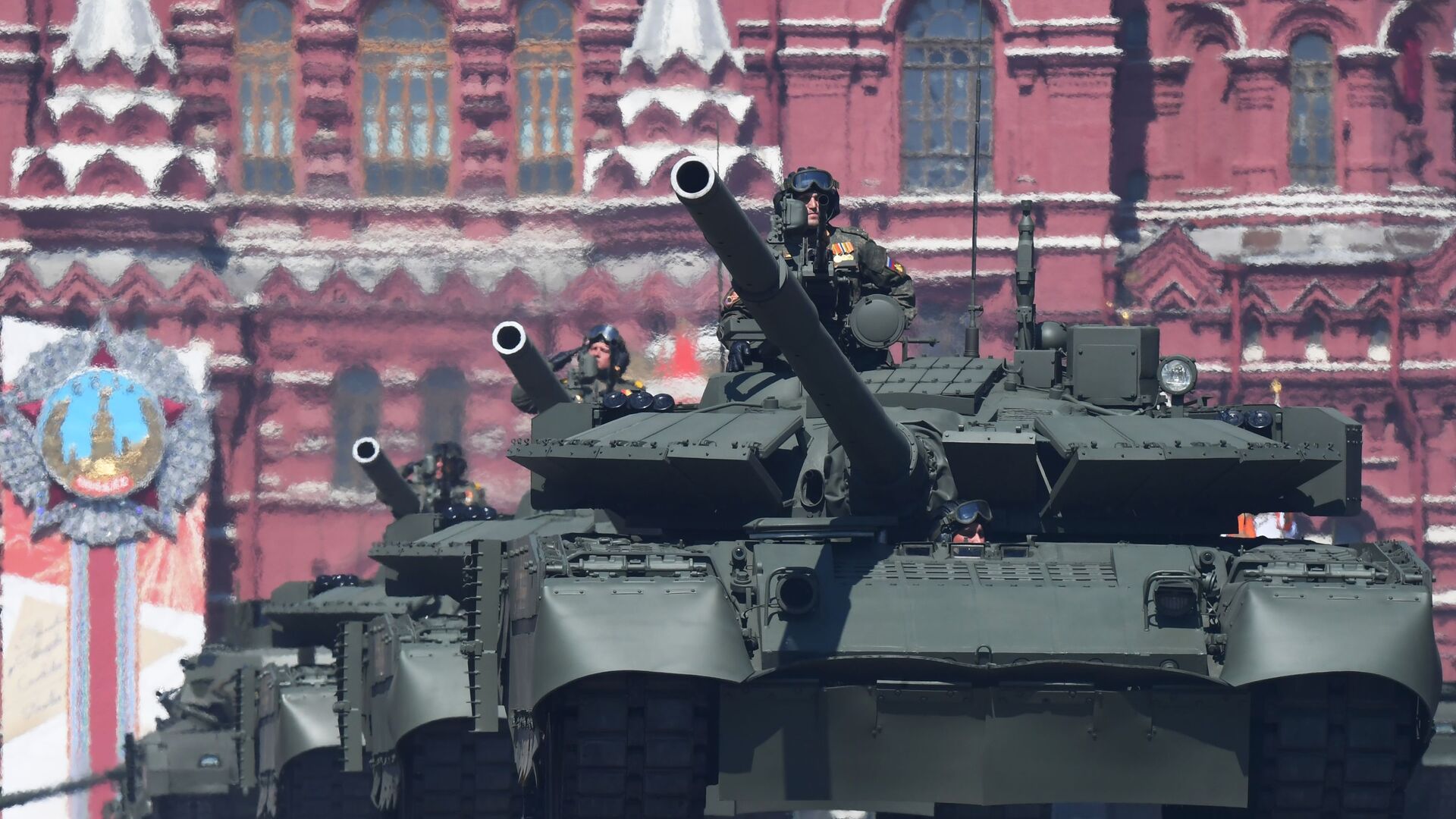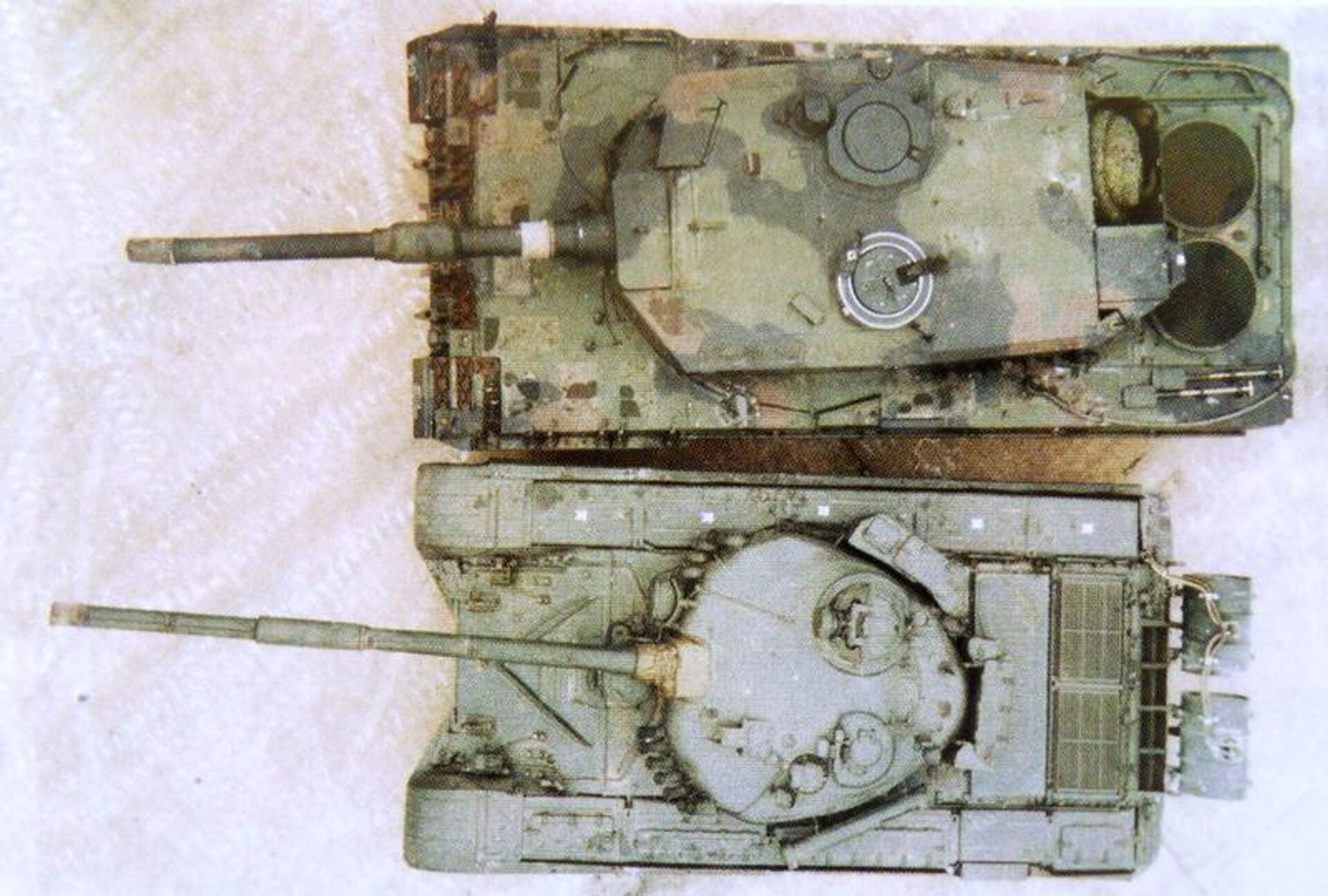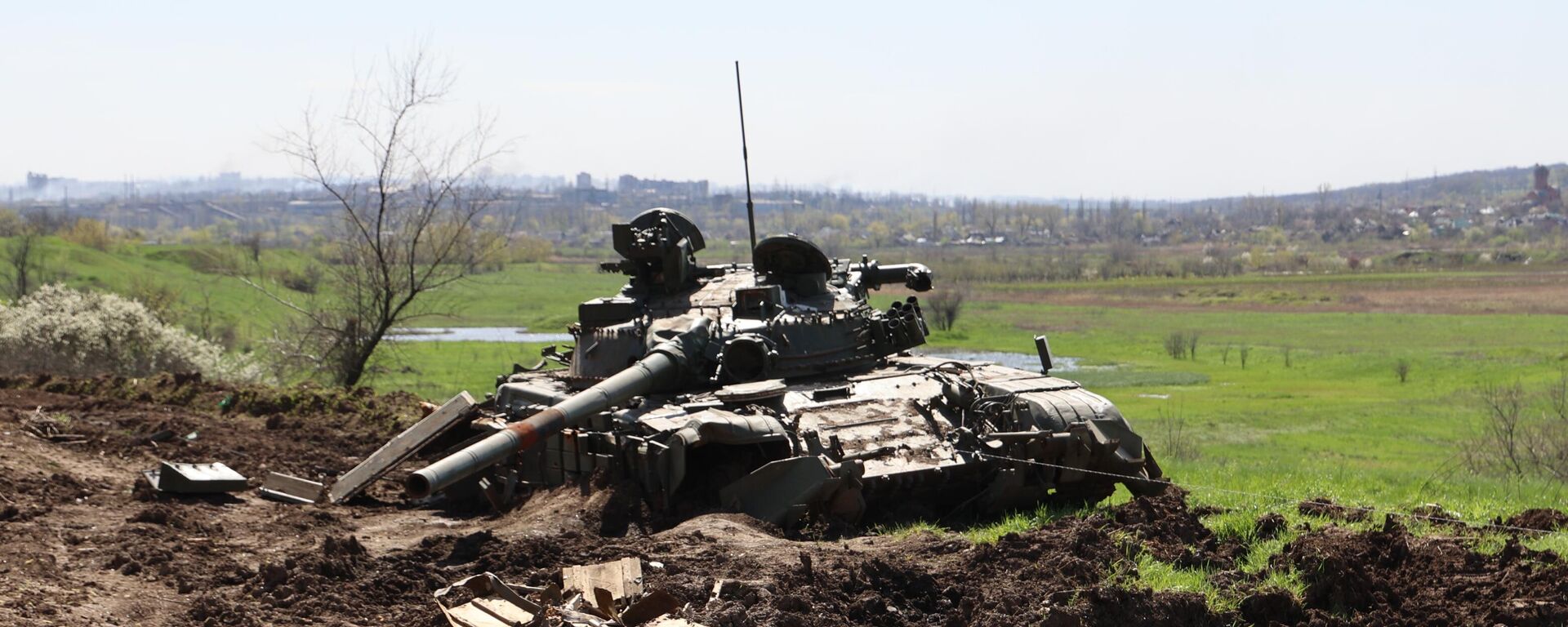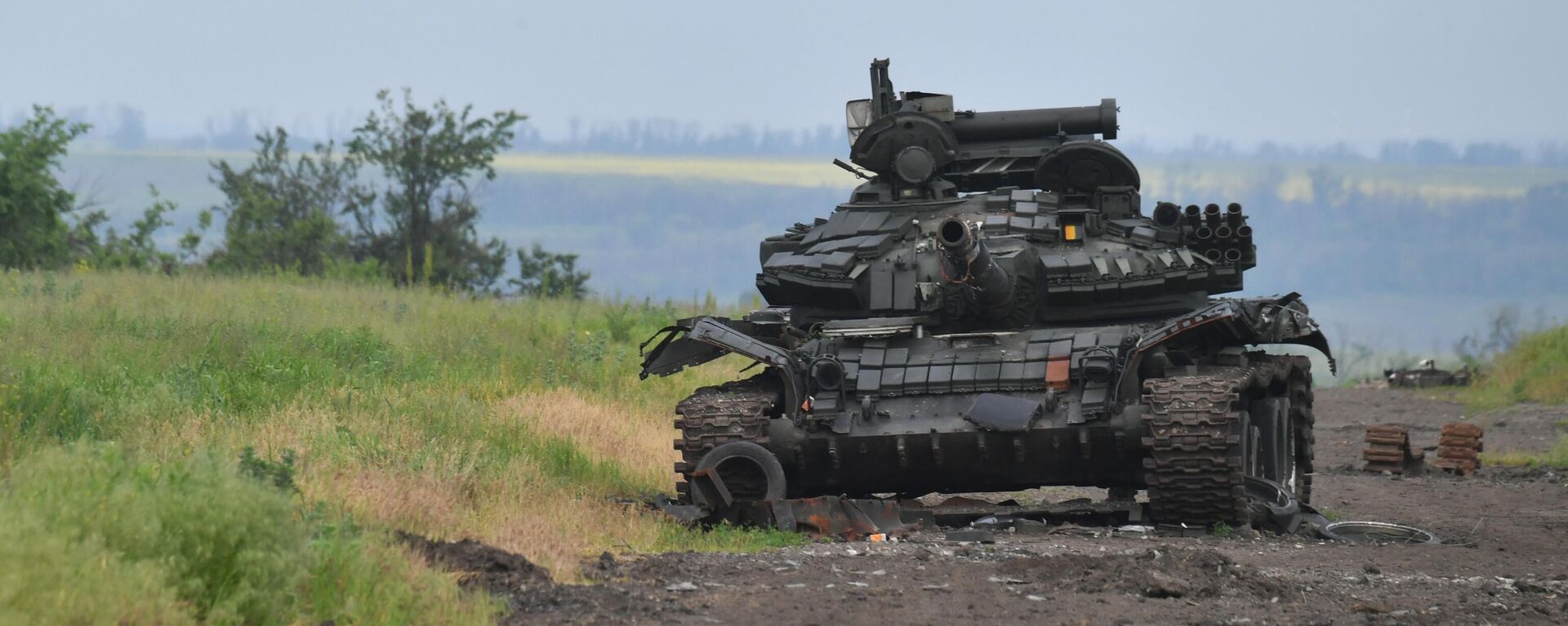Russian Tankers’ Day: Myth of NATO Armor’s Superiority Smashed in Ukraine

© RIA Novosti
/ Subscribe
For decades, the large, sleek, technologically advanced main battle tanks used by NATO’s armies enjoyed a distinct air of superiority over their Soviet and Russian counterparts in the minds of Western war planners, military experts, and the public at large. The Ukraine conflict has busted this myth. What happened and why? Sputnik explains.
Sunday is Tankers Day, a professional holiday dedicated to the commanders and crews of the Russian military’s heavy armor. Established in 1946 after the Great Patriotic War, which witnessed many of the largest tank-on-tank battles in history, the holiday was designated to point out “the special importance of the tank and mechanized troops,” both in the Second World War, and in modern warfare generally.
In the decades since, tank warfare has seen a number of evolutions, starting with the massive buildup of armored forces in Central Europe during the Cold War, when NATO commanders expected to hold back endless columns of Soviet tanks rushing toward the English Channel, in the event that the decades-long Cold War confrontation suddenly turned hot.
Between 1946, when the Cold War began, and the early 1990s, where hundreds of thousands of Soviet troops were pulled out of Eastern Europe in exchange for fleeting promises from the West not to expand NATO eastward beyond a reunified Germany, global tank design underwent at least three distinct, but overlapping, generations:
the first generation (1946 to about 1965) saw the birth of the first modern main battle tanks as we know them today, combining maneuverability, heavier armor, and more powerful anti-tank firepower. Examples of the first-generation MBTs include the Soviet T-54 and T-55, the British Centurion, and the American M48 Patton.
the second generation (about 1959 to the early 1980s), saw tanks fitted out with heavier, even more powerful main weapons, including the smoothbore tank gun, new kinds of advanced reactive and composite armor, consisting of layers of materials including metals and ceramics, higher reliability, greater horsepower engines, and improved radio communications systems. The Warsaw Pact and NATO countries developed and produced these tanks to until about the early 1980s, with the best-known examples from this era including the Soviet T-62, T-64, and T-72, the US M60, the West German Leopard 1, and the British Chieftain. The second generation also became the era where a host of nations which previously had no modern tank-building capabilities began to introduce their own, limited production designs, with Argentina, Brazil, India, Iran, Israel, South Africa, and Switzerland, to name a few, developing and fielding their own second-gen tanks as late as the mid-2010s.
the third generation, which began in 1976 with the development of the Soviet T-80 and its unique gas turbine engine, 125 mm 2A46 tank gun with automatic loader, multi-round ammunition capabilities (armor-piercing penetrator, High-Explosive Anti-Tank [HEAT] shaped charges, and High-Explosive Fragmentation rounds), composite armor, and electro-optical active protection system leading the way.
Soviet/Russian and Western Tank Design Parts Ways
Western weapons makers soon followed suit, introducing advanced new tank designs like the Leopard 2 (1979), the M1 Abrams (1980), and Challenger 1. It was during the third generation that Soviet and NATO tank designs began to radically part ways. While Western tanks featured many of the same technical and armaments-related features as the T-80, plus high-tech perks like computer-assisted fire control and flashy TV monitors, they were also far larger, and generally far taller, than their Soviet counterparts, which continued to place a premium on a smaller, lower to the ground silhouettes.
For example, while the T-80 and its successor, the T-90, had an overall mass of between 42.5 and 46 tons, a height of 2.22 meters, a length of 9.6-9.9 meters and a width of 3.4-3.8 meters, NATO tanks became chunkier, with the Leopard 2 weighing in at over 62 tons, standing a whopping 3 meters tall, and measuring nearly 10 meters long by 3.75 meters wide. The Abrams, by comparison, weighs an eye-watering 73.5 tons, is 2.44 meters tall, 10 meters long, and 3.66 meters wide. Finally, the Challenger 1 saw a similar growth spurt, with a curb weight of up to 70 tons, a height of 2.95 meters, a length of 11.5 meters, and a width of 3.5 meters. Its early post-Cold War era successor, the Challenger 2, is even larger, weighing in at 75 tons, and measuring 13.5 meters by 4.2 meters by 2.5 meters, respectively.

A rare photo featuring a side by side comparison of an 80s Leopard 2 vs a Soviet-era T-72, predecessor to the T-90 series of MBTs.
© Photo : Twitter / @STRATMIL
What explains NATO’s 80s "bigger is better" obsession vs. the Warsaw Pact’s "sleek and nimble" vision? The departure in design paths can be explained by the two blocs’ differing doctrines. While Western planners saw their machines in the light of hypothetical tank-on-tank showdowns, creating systems which they felt would be superior to individual enemy tanks in the fields and woodlands of western Germany, the Soviet military continued to see MBTs as a component of a well-oiled combined arms machine, designed to make rapid armored breakthroughs through rear areas, surrounding enemy armies and robbing them of supplies and routes of escape.
It was during the third generation of tank design that the myth of the superiority of Western tanks against their Soviet and Russian counterparts was born – in part thanks to the fetishization of not just armor, but virtually all the latest Western armaments in popular fictional works by authors like Sir John Hackett and Tom Clancy imagining Western miracle weapons defeating endless hordes of Soviets.

Rare photo showing a side-by-side size comparison between a Leopard 2 and a base T-72, predecessor to the T-90 series of tanks.
© Photo : Twitter / @STRATMIL
These narratives were reinforced in the 1990s, 2000s, and 2010s, when the US and its allies launched a series of invasions and bombings against Soviet-equipped armies in Iraq, Yugoslavia and Libya, destroying scores of stripped-down monkey model main battle tanks while losing few, if any of their own.
Ukraine Proxy War Busts West’s Myths
It would be during the NATO-backed Ukrainian Army’s ill-fated counteroffensive against heavily entrenched Russian positions in Donbass and Zaporozhye this summer that the Western bloc finally discovered that without effective air, artillery, and intelligence support and demining, their latest tanks would burn just as easily as any of the leftovers sent east from Eastern European NATO members’ Warsaw Pact armories. Open-source intelligence has confirmed the destruction of dozens of Leopard 1 and Leopard 2 tanks in Ukraine, including the Bundeswehr’s latest models. Furthermore, at least two of the 14 Challenger 2s sent to Kiev were destroyed by Russian forces this week after finally being shipped to the front.
Russian tanks taking part in the special military operation demonstrated the continued importance of a sleeker, lower silhouette to modern tank warfare, as well as the role of superior speed and maneuverability characteristics in keeping tanks and their crews alive. Russian tanks' larger, slightly more powerful main guns (125 mm smoothbores vs 120 mm smoothbores) have also proven their significance.
“Whatever tasks are set before Russian tank forces, they will be carried out. But lately, for the most part, tanks have been performing tasks of firing from covered fire positions, something which [Russian] tank forces have otherwise not done in a long time," Colonel (ret.) Sergey Suvorov, a candidate of military sciences specializing in armored warfare, told Sputnik.
"Now they’ve remembered this mission, and today, with the help of unmanned reconnaissance systems, this kind of operation can be taken to a new qualitative level,” Suvorov said, recalling the example of the Alyosha tank crew operating an upgraded T-80 destroying two Ukrainian T-72Bs, an M113 armored personnel carrier, and five MaxxPro APCs while dodging enemy fire and towing a comrade’s damaged tank to safety.
What’s the Makeup of Russia’s Modern Tank Forces?
“Today the tanks [Russia has] in service include new modifications of the T-72, the T-80, and the T-90 – including the T-72B3 of the 2022 model year, the T-80 BVM and the T-90M Breakthrough,” Suvorov explained.
“When some say ‘yes, well these are old tanks that were modernized and so on and so forth,’ they forget that this is the generally accepted practice around the world. The Americans made their last modification to the Abrams somewhere in the early 2000s, the Germans had it with the Leopard 2A6, 2A7+,” the observer added.
In other words, while the base design of the tanks might date back to the late Cold War, both Russia and NATO have worked over the decades to modernize the heavy armored vehicles for the conditions of early 21st century warfare, packing them with new fire control systems, new sights and observation systems, upgraded main guns, better armor, and new active defense systems.
“Our new armor has improved fire control systems, sighting and observation systems, it’s equipped with thermal imaging channels, TV channels, target tracking equipment which allows for guided projectiles to be fire through the barrel of the tank gun, which, in general, Western designers haven’t done, for some reason. In other words, the modern tank models we have in service today are, in general, of the same quality, and in terms of their characteristics and combat properties are at a very high level,” Suvorov noted.
The observer further pointed out that today, Russian tanks are not being used in the conditions that NATO imagined at the dawn of the third generation of tank design – when it was speculated that large columns of tanks would march toward one another.
Russia’s Unique Schools for Tankers
Suvorov emphasized that Russia’s tank schools are unique, featuring the tried and tested Soviet teaching methods - something no other country has yet to top, and staffed by veterans of tank warfare from Afghanistan, Chechnya, and most recently, the special military operation in Ukraine.
“Today, with the development of small, unmanned drones, work is underway to ensure the interaction of tanks with such reconnaissance means to enable them to receive information in real time. And, in fact, with the T-90M 'Proryv' ['Breakthrough'], this system has already been worked out,” Suvorov summed up.
The Russian military’s calculations regarding the deployment of hundreds of NATO main battle tanks in Ukraine has proven correct, with Kiev’s counteroffensive largely stalled and failing, for the most part, to break through even the first line of Russian defenses over the past 90+ days. This, in part, serves to confirm what Sputnik has been saying ever since the announcement that NATO would be sending in its tanks in January: that real-world performance depends not just on on-paper characteristics of one tank versus another, but factors ranging from artillery and air support, to anti-tank missile-wielding infantry, to strategic and tactical level battlefield intelligence, commander competence, and last but not least, the skill of individual tank crews.




